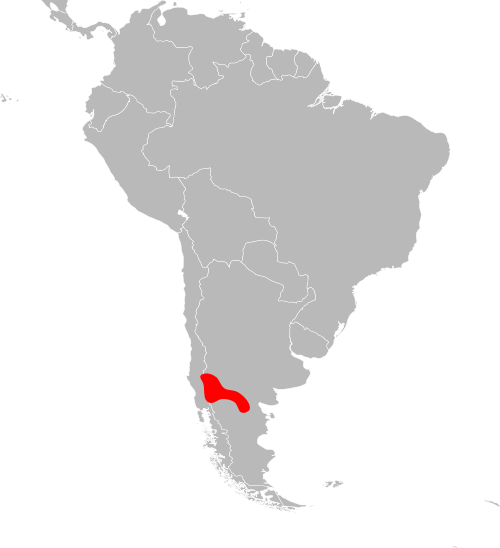Since my last bout of distribution maps [1], a couple new posters have gone up. They were both about lizards native to the southern end of South America, in the nations of Argentina and Chile. I presume they're part of an ongoing effort by BYU biologists to document the species diversity of an area of South America known as Patagonia.[2] The first, Diplolaemus, consists of four species, all found in South America and all considered types of iguana. The other poster only dealt with a single species, Cnemidophorus longicaudus. The common name for lizards in the genus Cnemidophorus is "whiptail" or "racerunner". C. longicaudus is the southernmost lizard in this genus and it is exclusively found in the Monte Desert region.[3]
And here you are. First, Diplolaemus:
Since I was able to make maps for all four species of Diplolaemus, I also made a map for the genus as a whole, with the ranges for D. bibronii and D. darwinii overlapping.
And a map of Cnemidophorus longicaudus:
And here you are. First, Diplolaemus:
 |
| Diplolaemus bibronii |
 |
| Diplolaemus darwinii |
 |
| Diplolaemus leopardinus |
 |
| Diplolaemus sextinctus |
Since I was able to make maps for all four species of Diplolaemus, I also made a map for the genus as a whole, with the ranges for D. bibronii and D. darwinii overlapping.
 |
| Diplolaemus |
And a map of Cnemidophorus longicaudus:
 |
| Cnemidophorus longicaudus |
I added the map for the genus Diplolaemus to the Wikipedia page (here). There were no relevant Wikipedia pages, yet, for the other maps I've created.
Notes:
[1] See here, here, here, here, here, and here.
[2] When Magellan landed there in 1520 he and his crew claimed to have seen giants that were twice the height of any man on the crew. Magellan named these people Patagão (which his Spanish crew pronounced Patagón), but did not give a reason why. It has since been assumed that it was derived from the Portuguese word for foot, pata, and that the name thus means "Land of the Bigfeet". Modern scholarship suspects that these people were actually the Tehuelche people, who are typically tall. See http://en.wikipedia.org/wiki/Patagon.
[3] See Yoke, M. M.; Morando, M.; Avila, L. J.; and Sites, Jr., J. W. (2006) "Phylogeography and Genetic Structure in the Cnemidophorus longicauda Complex (Squamata: Teiidae)." Herpetologica, 62 (4): 420–434.
Image attributions:
Cnemidophorus longicaudus distribution is by Ninjatacoshell, available at http://commons.wikimedia.org/wiki/File:Cnemidophorus longicaudus distribution.svg.
Diplolaemus bibronii distribution is by Ninjatacoshell, available at http://commons.wikimedia.org/wiki/File:Diplolaemus bibroni distribution.svg.
Diplolaemus distribution is by Ninjatacoshell, available at http://commons.wikimedia.org/wiki/File:Diplolaemus distribution.svg.
Diplolaemus darwinii distribution is by Ninjatacoshell, available at http://commons.wikimedia.org/wiki/File:Diplolaemus darwinii distribution.svg.
Diplolaemus leopardinus distribution is by Ninjatacoshell, available at http://commons.wikimedia.org/wiki/File:Diplolaemus leopardinus distribution.svg.
Diplolaemus sextinctus distribution is by Ninjatacoshell, available at http://commons.wikimedia.org/wiki/File:Diplolaemus sextinctus distribution.svg.
No comments:
Post a Comment